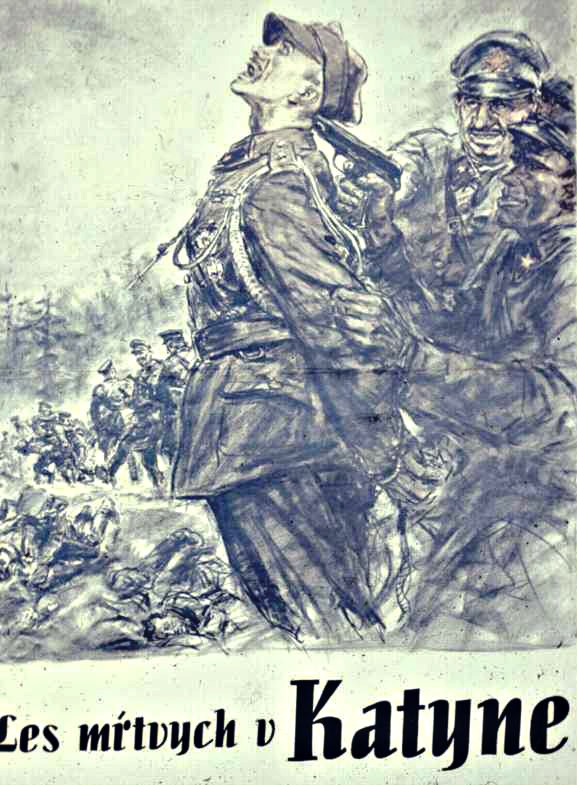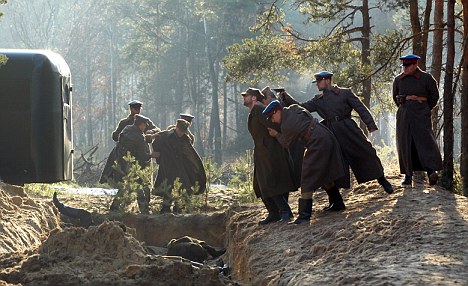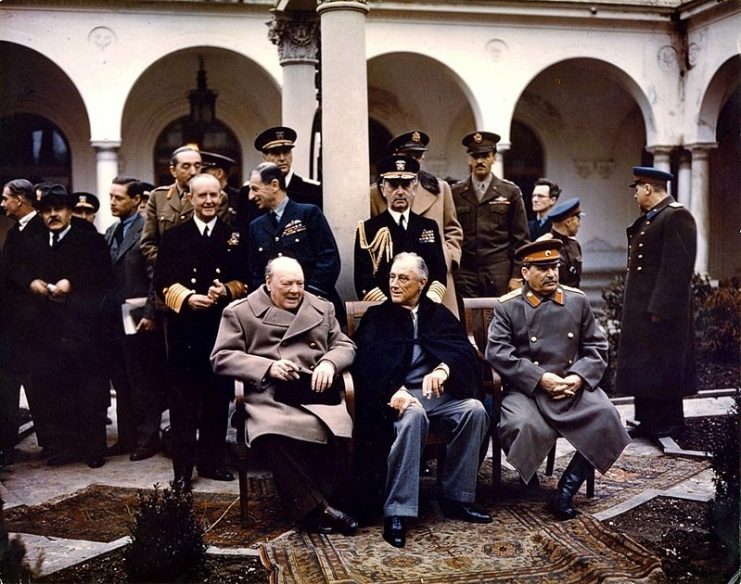The Devils’ Pact

Above: A German poster purporting to show the murder of the Polish officers in 1940 by the Soviet NKVD. The Soviet union had invaded half of Poland in 1939 with the agreement of the Germans. Now the Germans tried to distract attention from their own crimes by publicising the massacre.
I. Original texts of Soviet-German secret agreements concluded in the 1939-1941 period.
1) Secret supplementary protocol on the border of the spheres of interest of Germany and the USSR. Signed by V. M. Molotov and Ribbentrop on August (handwritten annotation:) Copy to Comrade Stalin.
2) Clarification of the secret supplementary protocol of August 23, 1939. Signed by V. M. Molotov and Schulenburg on August 28, 1939.
3) Confidential protocol concerning the possibility of resettling the population residing within the spheres of interest of the governments of the USSR and Germany. Signed by V. M. Molotov and Ribbentrop on September 28, 1939.
4) Secret supplementary protocol on changing the Soviet-German agreement of August 23 with regard to the spheres of interest of Germany and the USSR. Signed by V. M. Molotov and Ribbentrop on September 28, 1939.
5) Secret supplementary protocol on preventing Polish agitation on the territory of the other treaty signatory. Signed by V. M. Molotov and Ribbentrop on September 28, 1939.
6) Protocol on Germany’s renunciation of claims to the part of the territory of Lithuania indicated in the secret supplementary protocol of September 28, 1939. Signed by V. M. Molotov and Schulenburg on January l0, 1941.
7) September 28, 1939, declaration of the Soviet and German governments on mutual consultation. (In Russian and German)
8) Exchange of letters between V. M. Molotov and Ribbentrop on September 28,1939, concerning economic relations between the USSR and Germany In Russian and German, along with drafts.
9) Two maps of Polish territory with the signatures of J. V. Stalin and Ribbentrop.

Above: Soviet premier Josef Stalin (second from right), smiles while Soviet Foreign Minister Vyacheslav Molotov (seated), signs the non-aggression pact with German Reich Foreign Minister Joachim von Ribbentrop (third from right), in Moscow, on August 23, 1939. The man at left is Soviet Deputy Defense Minister and Chief of the General Staff, Marshal Boris Shaposhnikov. The nonaggression pact included a secret protocol dividing eastern Europe into spheres of influence in the event of a conflict. The pact now guaranteed that Hitler’s troops would face no resistance from the Soviets if they invaded Poland.
The 1939 Soviet invasion of Poland was a Soviet military operation that started without a formal declaration of war on 17 September 1939. It was during the early stages of World War II. Sixteen days after Germany invaded Poland from the west, the Soviet Union did so from the east. The invasion ended on 6 October 1939. Germany and the Soviet union divided the whole of the Second Polish Republic.
In early 1939, the Soviet Union asked the United Kingdom, France, Poland, and Romania to make an alliance against Nazi Germany. The Soviet Union wanted Poland and Romania to let Soviet troops go through their territory. Poland and Romania both said NO. The Soviet Union made a secret deal with Nazi Germany on 23 August. They planned to divide Northern and Eastern Europe into German and Soviet lands. One week later, German forces invaded Poland from the north, south, and west. Polish forces then withdrew to the southeast to wait for French and British support. The Soviet Red Army invaded the Kresy on 17 September. The Soviet government said it was acting to protect the Ukrainians and Belarusians. Soviet propaganda played a significant role in creating such an illusion, and it was even the more effective because the Soviet aggression occurred during a period of already significant fatigue and despair resulting from the German offensive.
Soviet propaganda played a significant role in creating such an illusion, and it was even the more effective because the Soviet aggression occurred during a period of already significant fatigue and despair resulting from the German offensive.

Above: Red Army soldiers distributing the Soviet propaganda newspapers to peasants near Wilno (Vilnius) in Soviet occupied part of Poland.
The invaders continued to repeat that they came to help, and cries „Beat the Germans” were heard everywhere. The propaganda fulfilled its purpose to such an extent that in some places the Soviets were greeted with flowers and cries of joy. During the same period, Molotov summoned the Polish ambassador in Moscow and told him that „as the Republic of Poland had ceased to exist” measures had been taken to protect the residents of western Belarus and Ukraine.
Both France and Britain were stunned by Russia’s intervention, however, they did not declare war on Russia. The reaction of France and Britain to the Soviet invasion and annexation of Eastern Poland was muted, since neither country expected or wanted a confrontation with the Soviet Union at that time.
Under the terms of the Polish-British Common Defence Pact the British had promised assistance if a European power attacked Poland. When Polish Ambassador Edward Raczyński reminded Forein Secretary, Lord Halifax of the pact, he was bluntly told that it was Britain’s business whether to declare war on the Soviet Union.
Once the Soviets moved into Poland, the French and the British decided there was nothing they could do for Poland in the short term and began planning for a long-term victory instead… While the French had made promises to Poland, including the provision of air support, these were not honoured.
The Katyn lie. Its rise and duration!
The Katyn Massacre – Mechanisms of Genocide

In the spring of 1940, about 22,000 Polish officers, soldiers and policemen interned in Soviet prisons and camps were murdered upon the orders of the highest authorities of communist Russia (including Joseph Stalin).
Having divided Poland into separate spheres of influence under the Molotov-Ribbentrop Pact, Nazi Germany and the Soviet Union both invaded Poland in September 1939. While the Germans began the mass killing of Polish citizens in western occupied Poland, the Red Army arrested and imprisoned thousands of Polish military officers, policemen, and intelligentsia during their occupation of eastern Poland. Germany began World War II with an attack on Poland. It was then that Polish officers were interned in Soviet camps and prisons. According to the recommendations, Poles were to be killed without trial by officers of the Soviet political police – NKVD. This mass killing is referred to as the Katyń Massacre, the name deriving from the town of Katyń – one of several places where Polish officers were murdered.
The western Allies, principally Britain and America, found themselves caught up in a web of lies and deceit. The evidence pointed very strongly in support of the German claims. The British and Americans knew they were in an alliance with a despotic regime – and that the USSR, communist Russia, was perfectly capable of such crimes. Yet they were also fighting a war in which they depended on Stalin and had to do everything to support his regime.
The Soviet state continued to claim that the Germans had been responsible for the crime right up until the Soviet regime collapsed in 1989.
And… Poland betrayed by Western allies !

The Yalta conference, which started on February 4, 1945, even now is considered in Poland as a betrayal by Western allies. The summit, attended by the leaders and ministers of the Soviet Union, the US, and the United Kingdom, divided Europe into two spheres of influence and left Poland, as well as the other Eastern European countries, subjected to Soviet rule for many decades.During the talks led by Joseph Stalin, Winston Churchill, and Franklin D. Roosevelt, which lasted over a week, a number of arrangements were made regarding strategic cooperation in the final phase of WWII and the future of the world after the war.
However, Poland was the most thorny issue. As Winston Churchill wrote: „Poland was, in fact, the most urgent reason for convening the Yalta conference and it became the first of the major reasons that led to the breakup of the Great Coalition.”
As a result of the talks, it was decided that the Provisional Government operating in Poland under the patronage of Stalin would be the legitimate, recognised by the UK and the US, government of Poland. After its formation, the new government was obliged to carry out „free and unrestricted elections as soon as possible”.
In the statement from the Yalta Conference, there was no mention of the Polish Government In Exile in London, which was, by that time, still recognised by the US and the United Kingdom as Poland’s legitimate government.
###
In conclusion…
„The Nazi-Soviet pact is little remembered today in Australia. This is primarily due to the fact, following Germany’s invasion of the Soviet Union in June 1941, Stalin played an important role in Hitler’s defeat — which was consummated when the Red Army occupied Berlin in May 1945.
It’s also partly due to the fact the Left, which has dominated intellectual life in the West in recent decades, does not want to talk about the war between August 1939 and June 1941.
Yet the Left has been almost silent on the Nazi-Soviet Pact. Professor Stuart Macintyre, a one- time member of the Communist Party, does not mention it in his Oxford History of Australia and there is only a passing and misleading reference in his A Concise History of Australia. Left-wing historian David Day does not refer to the Nazi-Soviet Pact in his Menzies & Churchill at War, which conveniently begins on the first day of September 1939″.
/Extract from article: ”War pact between the Nazis and Stalin left out of history”/ Gerald Henderson’s Weekly Column/ The Sydney Institute/ August 22nd, 2014/
###
Antoni J. Jasiński
##################################################

Good article.